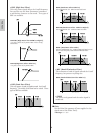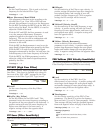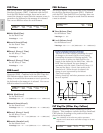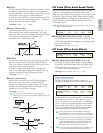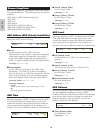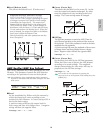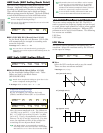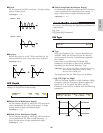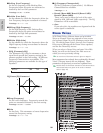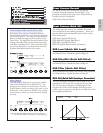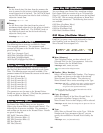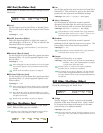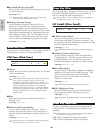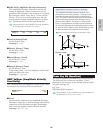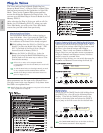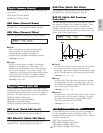
102
Voice Mode
■ LoFreq (Low Frequency)
Set the low frequency of the Shelving filter.
Frequencies below this point are attenuated or
boosted by the Low Gain parameter.
❏ Settings: 50.1Hz ~ 2.00kHz
■ LoGain (Low Gain)
Set the amount by which the frequencies below the
Low Frequency setting are attenuated or boosted.
❏ Settings: -32 ~ 0 ~ +32
■ HiFreq (High Frequency)
Set the high frequency of the Shelving filter.
Frequencies above this point are attenuated or
boosted by the High Gain parameter.
❏ Settings: 503.8Hz ~ 10.1kHz
■ HiGain (High Gain)
Set the amount by which the frequencies above the
High Frequency setting are attenuated or boosted.
❏ Settings: -32 ~ 0 ~ +32
• P.EQ (Parametric EQ)
The Parametric EQ is used to attenuate or boost
signal levels around the Frequency setting by the
amount specified in the Gain setting. 32 different
Frequency Characteristics are available. The
following parameters are available for this type of
Equalizer.
EQ Param (EQ Parameter)
■ Freq (Frequency)
Set the center frequency. Frequencies around this
point are attenuated/boosted by the Gain setting.
❏ Settings: 139.7Hz ~ 12.9kHz
■ Gain
Set the Gain. This attenuates or boosts frequencies
around the Frequency setting.
❏ Settings: -32 ~ 0 ~ +32
EQíParam) Freq Gain Q
EL1-3* 255 +32 31
■ Q (Frequency Characteristic)
Set the Q (Frequency Characteristic). 32 different
Characteristics are available.
❏ Settings: 0 ~ 31
• Boost6 (Boost 6dB)/Boost12 (Boost 12dB)/
Boost18 (Boost 18dB)
These can be used to boost the level of the entire
signal by 6dB, 12dB and 18dB, respectively. The EQ
Parameters will be unavailable.
• thru
If you select this, the equalizers are bypassed and the
entire signal is unaffected.
Drum Voices
With Drum Voices, different drum and percussion
Waves or Normal Voices are assigned to notes across
the keyboard (from C0 to C6) forming an entire drum
kit. For editing Drum Voices, there are five Common
Edit screens (affecting all the Drum Voices together)
and the five Drum Key screens.
When you select a Drum Voice and enter Voice Edit
Mode, you will see the Drum Voice Edit screen at
which you were previously editing.
An overview of the Drum Voices is given on Page 37.
Most parameters have already been explained for Normal
Voices. (The gray items in the tree diagram.) Those
parameters not previously covered are explained here.
Details about the functions common to both Drum Voices
and Normal Voices are given in the section “Normal
Voices” (Page 79).



